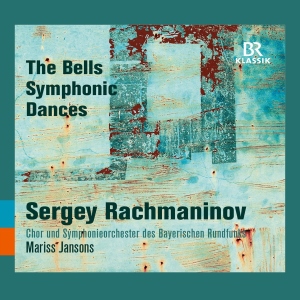RING THOSE BELLS
To say that these two tone poems are among Rachmaninov’s finest compositions may raise an eyebrow to those who find his Symphonies the best. Don’t take my word for it. Later in his life, the Great Russian believed that The Bells was his greatest achievement. And if you don’t believe The Rach and me, take a listen to this new recording of this choral symphony on Konstantin Balmont’s free translation of Edgar Allan Poe’s “The Bells”: The Bavarian Radio Choir and the BR Symphony Orchestra has given us the most splendiferous and glamorous rendering I have ever heard. And if you don’t believe me, then know it was nominated for this year’s 2019 Grammy Awards for Best Choral Performance.
The libretto (supplied English and German in the booklet) is preoccupied with the workings of Fate as it concerns the four aspects of human life (birth, marriage or love, terror and death) — all symbolized by four kinds of bells: silver, gold, brass and iron. The imagery evoked by the four sets of bells proved to be a potent source of inspiration, since their collective symbolism provides the large-scale integration of contrasts we hear. Rachmaninov uses his assembled forces with resourceful imagination in order to characterize the nature of the bells, as he believed that the symbolism was highly significant.
The music captures the moods implied by these titles, and Mariss Jansons’ Munich Residenz performance of January 2016 (the year the choir was last nominated for a Grammy) is most impressive in the way that it creates a rich atmosphere. All praise goes to the recording team and, especially, choir director Peter Dijkstra: both the recording and the choir have faithful perceptions and a muscularly engrossing presence.
The first movement of silver sleigh bells is scored for tenor solo (the lyrical Oleg Dolgov), chorus and orchestra. The initial rhythmic idea is given great character under Jansons, aided no doubt by the marvelous scoring; that charming atmosphere permeates the whole movement. The mellow wedding bells, a lyrical slow movement, utilizes a soprano (Tatiana Pavlovskaya, who has recorded The Bells before with Semyon Bychkov) to create flawless contentment, with music which is luxurious rather than jovial. The loud alarm bells of the third movement has no soloist, and the music seems more idiosyncratic and vibrant, and the multifaceted textures and rhythmic fluctuations add to the drama. The finale, the mournful iron bells, is a dark Lento lugubre for baritone (the fluent Alexey Markov); the heavy atmosphere has instruments playing in their lowest voices. Given its live recording, it’s amazing that this obscures all versions I’ve heard before, in both sound quality and as a musical experience.
For the Symphonic Dances, Jansons uses sensitive pacing in the first movement while keeping its rhythmic flavor impressively strong, bringing out the colorful and subtle orchestrations. The second movement – more or less an unhurried and expressive waltz – seems the influence of Tchaikovsky, with an ominous and commanding force as Jansons shapes the music prudently and emotionally, which adds to the passionate indulgence. The finale, using the music of the Russian Orthodox Church and the “Dies Irae” plainchant, moves with great urgency.
The religious imagery must have been important to Rachmaninov, who had been ailing for a while. These three Symphonic Dances are his final works, composed towards the end of his life, during the summer and autumn of 1940. Together, they form an extraordinary honor to the power of his inventive life-force. In 1943, shortly before his death, he remarked, “I don’t know how it happened, it must have been my last spark.”
RACHMANINOV: The Bells; Symphonic Dances
BR-KLASSIK
Bavarian Radio Choir and Symphony. Mariss Jansons
booklet (including libretto) in German and English
7 tracks | 74:19 | released on February 2, 2018
available on Amazon and iTunes


